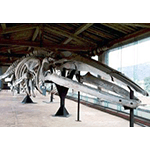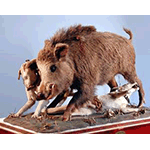Museo di Storia Naturale e del Territorio di Calci [Museum of Natural History and of the Calci Territory]
Already in the late 16th century, at the initiative of the Medici, a "Gallery" of natural specimens and curiosities was set up at Pisa's "Giardino dei Semplici" (the Botanical Gardens). This was the first core of collections that were to be continuously enriched, thanks to close ties with the University. Having become entirely independent of the "Giardino dei Semplici" (1814), during the course of the 19th century, under the direction of Paolo Savi, the Museum became one of the most important in Italy for its splendid zoological, geological, palaeontological, and mineralogical collections, as well as for its spectacular "whale gallery". Still today, after having moved from its old location in Via Santa Maria to the magnificent premises of the Certosa di Calci, granted for permanent use to the University of Pisa, it ranks among the foremost university scientific museums for the wealth and importance of its collections.
The first rooms narrate the history of the institution: rare and curious objects, decorated seashells and corals, perfectly re-create a Renaissance "chamber of wonders". Noteworthy are the groups of animals stuffed by Paolo Savi between 1820 and 1830, which aroused justifiable marvel at the Universal Expositions of the 19th century and were deemed insuperable by the major European museums.
The zoological collection consists of nearly 300,000 specimens, grouped in three main collections dating from the 18th and 19th centuries: the whale gallery is one of the most important and surprising collections of whale skeletons existing in Europe. The museum also has a gallery of reptiles and amphibians, with skeletons of enormous serpents, tortoise shells and a diorama of the iguana. In the section dedicated to mammals, visitors can admire a great tusk from the Elephans antiquus, which, when found on the beach near Livorno in 1881, was extensively discussed even in the pages of the "London News".
The very rich mineralogical and palaeontological collections were formed by outstanding figures in the Pisan scientific school: Giuseppe Meneghini, Antonio D'Achiardi, Leopoldo Pilla, and Mario Canavari. The majority of the specimens in these collections can be dated starting from the middle of the 19th century, although much older objects, coming from the Medicean period, are also displayed.
The Museum's historic Archive is kept at the Department of Earth Sciences, while the seventeenth-century inventories are now in the Pisa State Archives.
****************************
Texts by Mara Miniati
English translation by Catherine Frost
Last update 23/dic/2009





